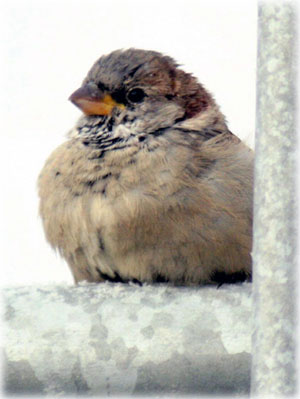 The singing sparrows of Shishmaref
The singing sparrows of Shishmaref
By Ned Rozell
April 29, 2008
Tuesday
This just in from Shishmaref science teacher Ken Stenek: On this
late April day, two house sparrows are singing their little hearts
out while perched on the metal roof of the Shishmaref School.
This is unusual, because the closest brethren of the tiny birds
are at least several hundred miles away, with most of the population
many thousands of miles away.
 A house sparrow perches
on a metal railing in the Seward Peninsula village of Shishmaref.
A house sparrow perches
on a metal railing in the Seward Peninsula village of Shishmaref.
Photo by Ken Stenek.
|
Stenek, who for the last decade has lived in the village on the
exposed sand spit just above the Bering Sea, saw a group of about
five birds near the school last October. At least two of them
seem to have survived a harsh winter in the windy village, and
birders have taken note.
The "house sparrow is a very rare visitor anywhere in Alaska,
with only a few records in the state," wrote renowned birder
David Sibley on his blog.
"Interestingly, one of
the few prior Alaska records comes from Gambell, on St Lawrence
Island, in mid-summer about 15 years ago. So the question is
whether these (Shishmaref) birds, at the very western edge of
Alaska, came from North America or Asia."
House sparrows are one of the most common birds in the Lower
48, but they don't normally occur farther north than about Fort
Nelson, British Columbia. The same species occurs in Asia, but
thousands of miles southwest of Alaska.
Stenek first identified the Shishmaref sparrows when he e-mailed
a photo to Dan Gibson, an ornithology research associate at the
University of Alaska Museum of the North. Gibson replied: "Where
in the world did you get those pictures of house sparrows?"
In Fairbanks, from his office at the museum, Gibson recently
said that if house sparrows are indeed residing in Shishmaref,
they might have reached there from the Russian Far East. Though
naturally occurring populations of house sparrows do not exist
close to northeastern Russia, people have introduced the house
sparrow to communities there several times in the recent past.
People brought a few house sparrows from Moscow to Provideniya
in the early 1990s, Gibson said. Shortly thereafter, a group
of researchers on a birding fieldtrip to Gambell found a dead
house sparrow in the dump there and brought it back to the museum
in Fairbanks. It was only the second specimen of a house sparrow
from Alaska; the other was a bird found in Petersburg. As for
the Shishmaref sparrows, Gibson had many questions on how such
a bird survived the winter in a place with such brutal weather.
"What are they doing to sustain themselves during the winter,
where are they roosting, where are they feeding?" he asked.
"I would have expected a bird like that to perish during
the winter."
He thinks that the Shishmaref sparrows are probably from one
of the communities in eastern Russia where people imported and
released them in the recent past. Another researcher has a theory
that the Shishmaref birds are the result of range expansion,
but Gibson doubts that.
"I think it's unlikely this would be a case of natural range
expansion in Asia, because of the absence of appropriate habitat
and a good travel corridor," he said.
Stenek has a guess that the birds couldn't have survived a trip
across the Bering Strait, and that they may have hitched a ride
in one of the many large boxes on a barge that came up last fall.
Right now, the origin of the birds is a mystery, and the two
male house sparrows sing from the roof of the Shishmaref School,
calling for a mate that probably isn't there.
This column is provided
as a public service by the Geophysical
Institute,
University of Alaska Fairbanks, in cooperation with the UAF
research
community. Ned Rozell [nrozell@gi.alaska.edu]
is a science writer at the institute.
E-mail your news &
photos to editor@sitnews.us
Publish A Letter in SitNews Read Letters/Opinions
Contact the Editor
SitNews
©2008
Stories In The News
Ketchikan, Alaska
|

